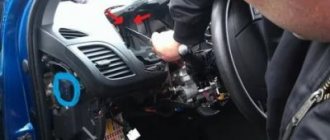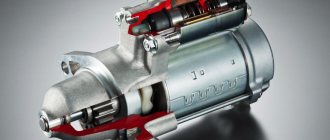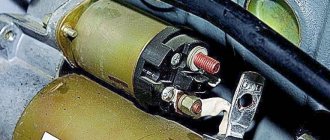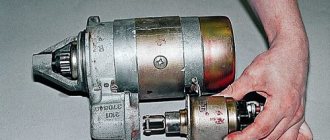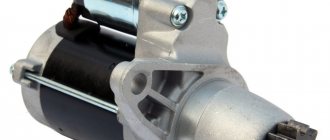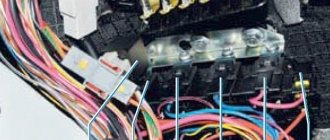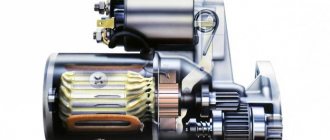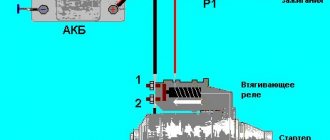If the car is after a trip, then before removing the starter on the VAZ, you should wait until all components and mechanisms have cooled down.
Regardless of whether a gear starter is installed on a VAZ 2106 or UAZ, the problems are similar. If the car does not start, the VAZ 2106 starter does not turn well, first check the quality of battery charging. In addition, you should check how well the terminals are secured. If everything is fine with the charging and terminals, then the cause of problems with starting the engine may be in the starter.
The following malfunctions of the VAZ 2106 starter are possible:
- The device turns on, but the traction relay does not work: the traction wire is broken, the tips are not tightened well, there is a short circuit in the traction windings or to ground, the contacts have oxidized, the retractor armature is stuck.
- After switching on, a click occurs, the traction relay works, but the armature does not function or it rotates too slowly, the starter does not turn: the fastening bolts on the retractor are not tightened well, the brushes are worn out or stuck, the commutator plates are short-circuited or are burned out, the windings are damaged.
- When starting, the relay clicks, the armature works, but the crankshaft does not rotate: the buffer spring is broken, the clutch slips, slips out of the axle, or the clutch engagement lever is broken.
- The starter does not turn off when the engine starts: the relay or drive lever is stuck, the contacts are stuck together, the mechanism is skewed, the ignition switch return spring is faulty.
- Increased noise during startup: the unit is poorly secured, the bushings are worn, the teeth on the gears are broken.
It is important to be able to quickly diagnose the problem and know how to deal with it. Below is a list of the most common car breakdowns.
The starter clicks but does not turn, what is the reason?
Good afternoon.
Many car enthusiasts are familiar with the situation when the starter clicks but does not turn. As luck would have it, such situations occur at the most inconvenient moments, for example, at gas stations or when leaving for work. In today's article, we will tell you how to determine the malfunction and, if possible, start the car to get to the repair site.
Before telling the troubleshooting algorithm, let's look at the starter device. For clarity, watch this video:
As you can see, the starter is a regular DC motor and relay. When you turn the key in the ignition and hear a click, it is the solenoid relay that clicks (the coil and contacts at the top of the screen in the video). If the starter does not rotate, but clicks, the following options are possible:
- The battery is dead.
- starter relay failed
- The contact coins in the solenoid relay are burnt.
- The starter brushes are worn.
- the starter armature is jammed.
- power plus is not supplied to the starter (because if there is no mass there will not even be retractor clicks)
Below we will analyze each of these faults in detail, and tell you which faults will allow you to start the car on the spot, using the existing starter, in order to get to the service station.
A severely discharged battery is the most common cause of clicking noises when turning the ignition key.
The error looks like this:
In our video you can see that when starting, at first, the starter barely turns the engine, and then it just crackles…. If the battery is severely discharged, the starter will not even try to crank the engine but will immediately make nasty clicking noises.
The fact is that the battery voltage is not enough even to operate the solenoid relay!
Options to solve the problem:
- light a cigarette from another car (we have a separate article about this on our website).
- start the car from a pusher/tug (if it has a manual transmission).
- remove and charge the battery.
Starter relay failure.
Relay failure manifests itself as a quiet click when turning the key.
In this case, you can start the car using a simple screwdriver. This is done like this:
Attention! If you are not confident in your abilities, you should not do this. It is better to contact specialists or call a tow truck. If you make a mistake when starting this way, the vehicle may move unintentionally or catch fire due to a short circuit.
Vehicle with manual transmission:
- set the parking brake.
- turn on neutral gear.
- open the hood and prepare a flathead screwdriver.
- turn the key in the ignition switch to the ignition on position.
- Using a screwdriver, we close two contacts on the solenoid relay (as in the video).
- After starting the engine, remove the screwdriver and drive to the repair site.
Car with automatic (+variator and robot) gearbox:
- install a car parking brake (for robot and variator).
- open the hood and prepare a screwdriver (possibly two).
- turn the ignition to the on position, press the brake, move the gear selector to the parking position (P).
- Using a screwdriver, we close two contacts on the solenoid relay (as in the video).
- After starting the engine, remove the screwdriver and drive to the repair site.
The contact coins in the solenoid relay are burnt.
This malfunction manifests itself in the form of loud clicks when the key is turned to the start position and the key is released. In some cases, the starter may trip.
Here is a video example of such a malfunction:
How to quickly diagnose contact patches?
Everything is extremely simple - open the hood, take a screwdriver, and bridge these two terminals:
If a spark jumps when the connection is made and you hear the sound of the electric starter rotating, you can be sure that your contact pins are burnt.
In this case, the car can be started with a screwdriver!
How to start a car with the starter when the contact pins burn?
Attention! If you are not confident in your abilities, you should not do this. It is better to contact specialists or call a tow truck. If you make a mistake when starting this way, the vehicle may move unintentionally or catch fire due to a short circuit.
In order to start the car when the contact pins burn out, you must simultaneously bridge all three contacts on the solenoid relay.
Closing the two contacts under the nuts is necessary to rotate the armature, and closing the control contact so that the overrunning clutch (Bendix) engages with the flywheel.
The procedure for starting a car if the contact pins fail:
Vehicle with manual transmission:
- set the parking brake.
- turn on neutral gear.
- open the hood and prepare a flathead screwdriver.
- turn the key in the ignition switch to the ignition on position.
- Using a screwdriver, we close all three contacts on the solenoid relay (sometimes one screwdriver is not enough and you have to take two).
- After starting the engine, remove the screwdriver and drive to the repair site.
Car with automatic (+variator and robot) gearbox:
- install a car parking brake (for robot and variator).
- open the hood and prepare a screwdriver (possibly two).
- turn the ignition to the on position, press the brake, move the gear selector to the parking position (P).
- Using a screwdriver, we close all three contacts on the solenoid relay (sometimes one screwdriver is not enough and you have to take two).
- After starting the engine, remove the screwdriver and drive to the repair site.
The starter brushes are worn.
The malfunction manifests itself in the same way as burning of the contact coins (loud clicks when turning the ignition key), the only difference is that when the brushes wear out, the starter will never rotate.
This is checked in the same way when bridging the contacts of the solenoid relay with a screwdriver.
The starter does not start to spin, it is sincerely not observed.
How to start the car?
Unfortunately, it is impossible to start the car with this starter; it must either be repaired or replaced.
If the car is equipped with a manual transmission, it may be possible to start it by push or tow.
If the car is equipped with an automatic transmission, it makes sense to call a tow truck or tow truck.
The starter armature is jammed.
The author of the article has encountered such a malfunction several times, but, as a rule, the brushes immediately become unusable and, without analysis, you will not be able to distinguish between armature jamming and brush wear.
If, by some miracle, the brushes hold up, then when you turn the key to the start position, you will hear a very loud click, and then, for a while, all the devices will go out (you may feel a specific smell)! Burning out of the mass manifests itself in exactly the same way!
In any case, the car will not go anywhere on its own. It is necessary to carry out diagnostics and use a tow truck/tug to proceed to the repair or parking area.
No power plus is supplied to the starter.
For clarity, look at this picture:
Without a test light or multimeter, you will not determine this malfunction! And in general, without instruments, it can be confused with brush wear!
As you can see, if the power wire running from the battery to the solenoid relay breaks, the starter will not work, but the solenoid relay will click.
If, upon visual inspection of the direct battery-starter wire, you do not see any damage, call a tow truck and go to the place of repair and diagnostics.
That's all for me today. Don't let the situation where the starter clicks but doesn't turn happen to you anymore. If you have any questions or if you want to add to the article, write comments!
Source
How to check the starter traction relay yourself
You can check the starter traction relay with your own hands using an autotester. To do this, you first need to measure the voltage from the battery at the starter contact. After this, the tester probe is connected to the starter output, after which it is necessary to turn on the ignition and turn the key to the “start” position.
During measurements, you need to pay attention to the following: if measurements at the input show a voltage that corresponds to the normal charge of the battery, but when the traction relay is activated, the voltage at the output drops 2-3 times, then there is a high probability of burning out the power contacts of the traction relay.
If the traction drive malfunctions, the starter clicks and does not turn the engine. The fact is that burnt contacts cannot transmit voltage completely due to insufficient contact.
If the input voltage corresponds to the voltage of a charged battery and a similar voltage indicator is noted at the output of the traction relay, then the contacts of the traction relay are in perfect order. This indicates that the breakdown occurred in the starter. In the first case, the traction relay should be disassembled, after which the contacts should be cleaned, and the jumper plate should also be cleaned. A non-separable traction relay should be replaced with a new or known-good device. In the second case, you will need to remove the starter for detailed diagnostics and troubleshooting of the device.
Nothing irritates a driver more than the silence of the starter in response to turning the key in the ignition. There are many reasons why a car won't start.
Starting from the banal disconnection of contacts, ending with the failure of the starter. External manifestations of a breakdown can also be different, and if you know the design of the starting system, you can quickly find a weak point.
If, when trying to start, the starter clicks and nothing else happens, this significantly narrows the troubleshooting sector.
Clicks under the hood when trying to start the engine are generated by the retractor relay, which is responsible for the engagement of the Bendix working gear with the flywheel ring. Not very experienced drivers believe that such clicks can be produced by the starter relay, and they consider the solenoid relay to be the culprit of the breakdown.
Reasons why the starter on a VAZ 2106 does not turn
Battery and terminal contact
- The battery is dead . Of course, experienced drivers will immediately understand when the battery is low, but some beginners may not understand that the reason is precisely the battery being low. Simply turn on the low beam and see how bright the lamps are. Usually, if the battery is low enough, the lamps may glow dimly or not light up at all. In this case, it is necessary to charge the battery.
- Poor contact of battery terminals . It also happens that all the instruments and lights on the instrument panel seem to be lit, electrical appliances are working, but the starter does not turn. If the contact at one of the terminals is poor, then there may not be enough current to crank the starter. To avoid this, it is necessary to lubricate the terminals with thick lubricant after each removal and installation of the battery. For example, like litol, and then such a problem will not arise!
VAZ-2101 starter: problems and solutions. Good old
Problems with the starter can occur no matter what make of car you have or how old it is. What can we say about the legend of the Soviet automobile industry, the VAZ “Kopeyka” 2101, if the last car of this model rolled off the assembly line in 1984.
Despite their honorable age, these cars still travel on the roads of the former Soviet Union, and the owners continue to repair them in their garages.
In this article we will talk about what the VAZ-2101 starter is, what malfunctions most often occur, and also consider methods for eliminating them.
Design features of a “penny” starter
The first “kopecks” were equipped with ST-221 launchers. Their design consisted of:
- housing, which is also a stator with field windings;
- two end caps;
- armature (rotor) with commutator and drive;
- solenoid relay.
In essence, SST-221 is a classic four-pole electric motor that consumes direct current from a battery. A special feature of this device was a collector with transversely arranged plates. In principle, all electric motors at that time had this design.
Over time, SST-221 replaced the new VAZ-2101 starter, modification 35.3708. By the way, it is still being produced today. Almost all VAZ “classics” were equipped with it. Structurally, it differs from its predecessor only in the presence of an additional winding of the solenoid relay, a longitudinal collector and an improved stator. All other elements remained the same, which made it possible and allows us to easily change the outdated model of the launcher to a new one without any modifications.
A faulty VAZ-2101 starter may show the following symptoms when trying to start the engine:
- the solenoid relay does not operate (does not click), the rotor does not rotate;
- the relay works, but the armature rotates too slowly;
- the traction relay is activated repeatedly, but the armature does not turn the flywheel;
- the relay works, the starter turns, but the flywheel does not rotate;
- operation of the starting device is accompanied by an uncharacteristic sound;
- The VAZ-2101 starter works normally, but does not turn off when the ignition key is released.
Now let's look at each of the signs in more detail.
The traction relay does not operate, the armature does not rotate
Symptoms such as these may indicate that:
- the battery is faulty or completely discharged;
- contact has disappeared at the battery pole terminals or at the connection between the tip of the positive wire and the starter terminal;
- an interturn short circuit or break has occurred in the winding(s) of the solenoid relay;
- the retractor armature jams.
The relay works, but the armature rotates too slowly
If, when starting the engine, the relay is activated, but the starter does not develop the required speed, this may indicate that:
- the battery is discharged;
- there is oxidation of the contacts on the battery or on the solenoid relay;
- burnt collector plates;
- brushes are worn out;
- One of the positive brushes shorts to ground.
If the VAZ-2101 starter solenoid relay is activated several times in a row when the key is turned, but the armature does not rotate the flywheel, the reason for this may be:
- battery discharge;
- voltage drop in the circuit due to oxidation of contacts;
- short circuit or break in the holding winding of the traction relay.
The starter works, but the engine flywheel does not rotate
In this case, the following malfunctions may occur:
- the freewheel clutch lever is broken or has come off its axis;
- clutch slip;
- the buffer spring is broken;
- Damage to the freewheel drive ring.
The starter works but makes an unusual noise.
Starter operation is accompanied by an uncharacteristic sound when:
- loose fastening and distortion of the device;
- damage to the cover on the drive side;
- wear of bearing bushings or shaft journals;
- violation of the fastening of the stator poles (contact of the pole with the armature);
- Damage to the drive teeth or flywheel ring.
The starter does not turn off in time
The reasons that the starter does not turn off after starting the engine may be:
- drive lever jamming;
- weakening of the springs of the traction relay or freewheel;
- jamming of the retractor relay armature;
- jamming of the coupling on the splines of the anchor shaft.
Before you start repairing
If you discover that the VAZ-2101 starter does not turn, do not rush to go to a service station or dismantle the device. First, you should make sure that the reason is in it, and not in the battery or wiring. First of all, check the condition of the battery terminals. If they show signs of oxidation, remove the wires from them and clean them thoroughly.
To check that the wiring is working properly, take a piece of multi-core cable and use it to connect the positive terminal on the starter to the corresponding battery terminal. This will directly connect the jump starter to the power source. This, of course, needs to be done with the ignition on and the gear off. If the starter works and your VAZ “kopek” starts normally, the reason must be looked for in the wiring or ignition switch.
Otherwise, the starting device will need to be dismantled for further diagnostics and repairs.
Removing the starter
To remove the starter in a “penny”, lift the hood, disconnect the terminals from the battery and remove the warm air intake hose running from the engine to the air filter. Next, you need to disconnect the heat-insulating shield.
The starter itself in all VAZ “classic” cars without exception is attached to the clutch housing with three 13mm bolts. We unscrew them with the appropriate key. After this, unscrew the nut securing the positive wire to the starter terminal.
The starter can now be removed by sliding it slightly forward.
Traction relay repair
First of all, unscrew the nut on the solenoid relay, which is located closer to the motor housing. Remove the winding output from the stud. After this, unscrew the three nuts securing the relay and disconnect it from the stator.
After unscrewing the nuts on both studs, you need to carefully unsolder the two contacts of the windings located on the back cover. After this, it can be removed. Carefully inspect the condition of all relay elements: spring, contact plate, nickels (contact bolts). The latter, by the way, very often burn, so it is recommended to clean them with fine sandpaper until they shine.
The same must be done with the plate. If signs of a starter malfunction point to the relay, be sure to check (ring) its windings with a tester. After making sure that the device is working, you can reassemble it in the reverse order. If any of its parts malfunctions, it will need to be replaced or the entire spare part assembly will need to be replaced.
Car starter: main purpose
Sooner or later, every car owner, regardless of its make and model, has to face the problem that his vehicle refuses to start. The first thing, naturally, is to check the fuel level, battery charge, and electronics. If all this does not cause any complaints and doubts about serviceability, then most likely the problem is in the starter. After all, successful engine starting depends on it.
Currently, as a rule, relays 35.3708 with an end-mounted collector are installed on cars of this model.
However, on some copies of the VAZ 2106, starters made in Germany or Belarus may be installed, since they can be interchanged with starter 35.3708.
At an earlier time, approximately in the 70-80s, the ST-221 starter was also installed.
What to do if the starter 2106 does not turn
What could be the reason why the starter 2106 does not turn? This behavior of the car will cause a lot of troubles, since it is impossible to start the engine with the key. There is only one option - from a tug.
But this is not very convenient, since it is not always possible, and sometimes even the desire, to push the car. Therefore, it is necessary to immediately find out why the starter does not rotate. And try to eliminate it as quickly as possible.
But first, a few words about how this electrical device works and for what purposes it is needed.
What is a starter?
A starter is a direct current electric motor capable of driving the crankshaft of an internal combustion engine. Moreover, the starter rotor and crankshaft are constantly open, and at the moment of starting, the gears located on them engage. At the top of the starter housing there is an electromagnetic retractor relay. It gets its name from its operating principle.
When voltage is applied to the relay winding, the core is “pulled” into the housing. In this case, the core performs two important functions:
- Moves the gear with the overrunning clutch along the rotor until it engages with the flywheel ring.
- In the extreme retracted position, the core presses on a small rod, which sets the copper plate in motion. The latter closes the power contacts and supplies voltage to the stator winding.
Please note that the VAZ 2106 starter clicks when it does not have enough power to spin the rotor. This happens when the battery is completely discharged.
It is worth noting that at first the rotor will rotate very slowly, as if with all its strength, after which it will stop completely and clicks will appear. But the battery may be in perfect condition. Yes, this happens too. Double-check all copper bars that lie between the battery negative, the body and the engine housing. They should not be oxidized or show signs of destruction.
Try to carry out timely maintenance of the VAZ 2106 starter. This is an electric DC motor, therefore, it has much less reliability than an asynchronous one. Unfortunately, the latter is very difficult to use in a car.
The service life of a mid-price starter is at least three years. At the same time, the price of one copy will fluctuate in the range of 2300-2700 rubles. For this reason, it is sometimes much easier to replace the entire assembly rather than repair it.
Starter failure 2106
But what to do if you have a breakdown while on the road, and you need to start the engine often? Another option is to constantly stop uphill or downhill. Or try to revive the car.
So, when you turn the ignition key it clicks - the problem is in the battery or ground circuit. It is likely that you left the car with the driver switched on, which caused the battery to discharge. You have two options - start the engine from a tug or light a cigarette from another car.
But what if all the electrical equipment works well, the voltmeter shows a full charge, but the starter 2106 does not turn? Then the problem may be hidden in the solenoid relay or wiring. Take a 12 Volt incandescent lamp and two pieces of wire.
Connect one edge to the power supply negative, and the other to a thin wire that fits the relay. When the ignition is turned on, the lamp should light up. If this does not happen, then there is damage to the wiring (or destruction of the contacts in the ignition switch chip).
Before performing all these steps, make sure that there is a solid wire from the ignition switch to the solenoid relay coil. In other words, there is no electromagnetic relay in the circuit (according to the same circuit as on VAZ 2108 and newer cars).
If it is present in the circuit, then check it too, since no voltage will be supplied to the pull-in winding. Of course, it is advisable to check if there is voltage at the ignition switch. This can be done using the same test lamp (we will assume that you do not have a multimeter on the road).
But you probably always have a reserve of money for a long journey (400-500 rubles). This is exactly the price of the solenoid relay for the VAZ 2106 starter. And you can buy it in any store. Therefore, if it fails, it is easier to replace it completely.
Please note that the last measurement is with the key turned to the extreme position on the starter winding 2106. This way you will determine whether the voltage from the battery is switched to the starter windings.
What if it’s not an electrician?
It often happens that the electrics are all in perfect condition, but the starter 2106 does not turn, or rather, its rotor rotates, but the movement is not transmitted to the engine crankshaft. In this case, you need to look for a breakdown not only in the above-mentioned retractor, but also in the bendix - a device by which rotational motion is transmitted from the rotor to the flywheel.
Checking the functionality of the solenoid and contact relay
When the VR is not working well, when you try to start the engine, clear dry clicks are heard; if the cause of the defect is a contact relay, the clicking in this case is quiet and quite soft. First, we check the functionality of the starter itself, this is done something like this:
- remove the starting device from the car;
- We connect the terminal wires to the removed battery, connecting their other ends to the main positive and ground of the starter;
we connect another wire to the starter winding, with its other end we touch the positive terminal of the battery, while holding the starting device;
if the starter is working, the bendix will engage, the rotor will rotate, if not, there will be no rotation, and when voltage is applied, slight sparking will occur;
To completely make sure that the starter does not respond or, on the contrary, responds to the power supply, we apply plus directly to the winding.
Now, without disassembling the starter assembly, you can check the operation of the solenoid relay:
- apply minus to the winding output;
briefly touch the BP contact pin, where power is supplied from the ignition switch (on many cars this contact is equipped with a “chip”);
when power is applied and the relay is working properly, a clear click will be heard, and the bendix will move backward;
- if the bendix does not come out, you need to disassemble and diagnose the solenoid relay.
We recommend: Causes of misfire errors and how to fix them yourself
You can also check the VR when it is removed from the starter; here we also supply power with wires from the battery (plus and minus). When “+” is applied to the control contact, the core on a working relay will be retracted; if the VR is faulty, the full stroke of the core is not observed.
The starter contact relay (SCR), which is usually located inside the car or in the engine compartment on the panel next to the windshield wipers, may also be faulty. In this case, when you turn the ignition key, faint clicks may be heard, or more often no sounds can be heard at all. Before you start checking the RPC itself, you need to make sure that power is supplied to the relay. It is convenient to check the presence of voltage using a test light by connecting the ends of the probes to the corresponding terminals; the minus here should be constant, and the plus should appear at the appropriate position of the ignition switch (Z.Z.).
It should be taken into account that each car model has its own circuit, some cars have a starter blocking relay installed (has a different purpose), some cars do not have a starter lock relay at all. You need to check the chain according to the electrical diagram, but the principle of operation, we assume, is generally clear. If the plus does not come to the corresponding contact in the block, the 3Z contact group is probably faulty, there may also be a break in the wires, a poor connection in the blocks, in some cases, upon careful inspection, you can see traces of melted insulation.
